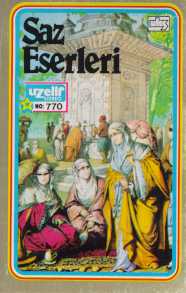4. Modernist musicology 1: Ottomanist monumentalism
Yilmaz Öztuna, whose politics are explicitly stated in the
biographical note at the end of his Türk Musikisi: Teknik ve
Tarih (1987), clearly represents the convergence of Islamism
and laissez faire economics that have dominated, with
interruptions, Turkish politics since 1950. This date marked the
election of the explicitly anti-secularist Adalet Partisi, for
whom Öztuna was later elected as MP in the home of radical
Islamism, Konya, in 1969. Öztuna later became a member of the
influential TRT supervisory committee (denetleme kurulu)
in which he militated against what he continues to see as the
sterile folklore promoted by Kemalist intellectuals of the 1930s
and 40s. He used his influential position in the TRT and the
Ministry of Education to promote Turkish art music on radio and
television, and to ensure the presence of an art music teaching
programme at the State Conservatory in Istanbul, when it opened
in 1976. Öztuna's characteristic stance is one of a Turkish
nationalism that is rooted in, rather than opposed to, the
achievements of the Ottomans.
It is not difficult to understand why Öztuna chooses Arel as
his particular hero; the following is an attempt to summarise the
argument and material of his recent biography. Huseyin Sadeddin
Arel (1880-1955) was, to follow Nettl's useful distinction
(1978), a classic moderniser. In Öztuna's words, from a cultural
point of view he was Turkish , but methodologically speaking he
was in the most profound sense, and in the full meanig of the
word, 'western' (6)
(1986:71). Fluent in Arabic and Persian, Arel's teaching,
theoretical and historical writing were much influenced by the
work of musicologists associated with modernist reform projects
in neighbouring states, such as, for example, the 1932 Egyptian
congress (see Racy 1992). Arel's outlook was, in many ways, that
of the late Ottoman bureaucratic elite. His father was an ulema
official in Izmir (kadi), and he studied in a Catholic
school in that city, later being sent to study (as was Öztuna)
in Paris. Arel worked as a private lawyer when the modern state
was established, and his expertise in matters pertaining to
commercial law, accumulated during his Ottoman bureaucratic
career, was much in demand. His musical life was therefore a part
time activity, but it was prolific in the extreme.
He taught in the much reduced Turkish art music section at the
Darulelhan, and then the Municipal conservatory, from which he
resigned in 1948. Öztuna suggests that Arel felt unable to
reconcile the demands of professional musicians on one hand and
conservative academics on the other, and in addition was
depressed by his failure to initiate a similar exercise in
Ankara. He founded the so-called 'Progressive Music
Conservatory', occupying the current ferry terminal building in
Besiktas, which he ran with one of his protegés, Laika Karabey.
Soon after, however, the centre of operations shifted from
Besiktas to his Bomonti house in Istanbul on Saturday afternoons,
where Arel conducted discussions which gathered together many of
the leading Turkish art music modernists: Adnan Saygun, Mesut
Cemil, Fahri Kopuz, Rusen Kam, Kemal Batanay, Ferit Alnar, Kemal
Ilerici, and Yilmaz Öztuna himself. The Musiki Mecmuasi,
which was the official voice of Arel's conservatory, published
from 1948 to his death, reflects the tone of these gatherings.
The Arel project can be summarised under four headings:
Firstly the notational systematisation of the makam system, and
the notation of the Turkish art music repertory. The system used
today is indeed the result of Arel's collaboration with Suphi
Ezgi and the physicist/mathematician Murad Uzdilek. Secondly a
historical project which was designed to assert, contrary to
Kemalist theory, the essential Turkishness of the art music
repertory. In Turk Musikisi Kimindir?, (1969) Arel argued
that the art music repertory should be seen not as a music which
represented a debased pan-Islamic civilisation, but as something
which the Turks had both contributed to and transformed. Thirdly,
Arel perceived the need to teach western techniques of
composition, in particular harmony and counterpoint to add a
lacking dimension to Turkish art music. He lead the way with a
large number of marches (including a setting of the national
anthem), duets, trios, quartets and quintets in various makam.
Almost as if to counter the accusation from conservatives, Arel
was also a prolific composer in the most conservative monophonic
styles, including no less than fifty-one settings of the Mevlevi Ayin-i
Serif.
 |
 |
Huseyin
Sadettin Arel's 'Mini Mini Nihavent Pesrevi' This piece is a standard
and widely performed instrumental opening pesrev for
suites in Nihavent makami. Uzelli's recording of these
standard instrumental pieces is accompanied by a
nostalgic view (adapted, presumably from a western
orientalist print) of 'Ottoman' Istanbul. In view of the
remorseless modernism of Arel's project, described in the
article, this subsequent 'nostalgisation' is somewhat
ironic.
|
| Cover
of Saz Eserleri |
|
|
Many of these compositions were published in Musiki
Mecmuasi. Finally he was concerned with modernising
performance, struggling with the invention of families of Turkish
instruments (along western lines) and a Turkish keyboard, and
putting together performances which involved large orchestras for
the first time at his conservatory in the 1940s. Arel's 'Turk
Musikisi Büyük Senfoni Orkestrasi' contained 15 violins, and
groups of four to five (each) kanun, ney, violin, ud
and tanbur. This was a significant advance on numbers of
instrumentalists which had anyway been growing due, as Behar
argues, to the increasing significance of public concert venues
during the second and third decades of the century (Behar
1993:124-6).
[Editor's suggestion: look for photos and
information on Turkish
instruments]
Forward | Back | Stokes main
page | References
